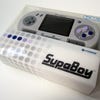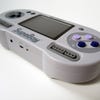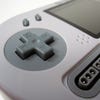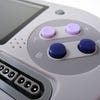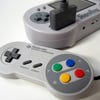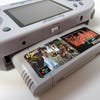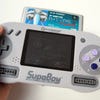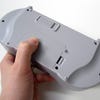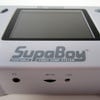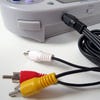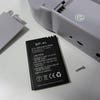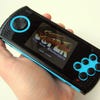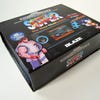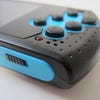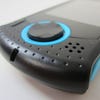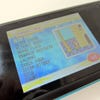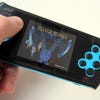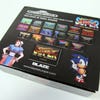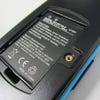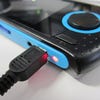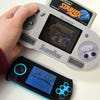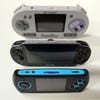Retro Handhelds Face-Off
Attack of the Clones! Mega Drive and SNES resurrected as handhelds - Digital Foundry checks them out.
Despite the prevalence of retro games on download portals such as Steam, PSN, XBLA and the Wii Virtual Console, many purists will tell you that you simply cannot beat the real thing. No digital service can replicate the reassuring click of a cartridge docking into a system or the authentic feel of original controllers and hardware. The big sticking point here is that vintage hardware is just that - vintage - and no longer in production.
Mercifully, the peculiarities of US patent law means that many illustrious machines from yesteryear are enjoying a timely resurrection, thanks largely to industrious companies in the Far East. Because hardware patents expire after twenty years, it's perfectly legal to create clones of famous retro consoles; the market is full of NES, SNES and Mega Drive impostors, some of which are so versatile that they will happily accept games from all three formats.
Of course, the manufacturers of these devices benefit from two decades of subsequent technological advancement, and are able to offer miniaturised marvels which would have been impossible back in the early '90s. In a special rose-tinted Digital Foundry Retro Face-Off, we've selected two leading lights in the retro handheld arena: The Hyperkin SupaBoy and the Blaze Mega Drive Arcade Ultimate Portable. It's Sega versus Nintendo all over again.
Introducing the Hyperkin SupaBoy
The eagerly-awaited SupaBoy isn't the first cloned SNES portable - the Yobo FC-16 Go precedes it by some margin. However, Hyperkin has a solid reputation in the cloning community, and therefore this device has gained a considerable degree of attention.
With dimensions of 210x100x38mm, the SupaBoy pushes the limits of what qualifies as portable device. The console is massive, effortlessly dwarfing the PlayStation Vita and Nintendo 3DS. Needless to say, you're unlikely to be stashing this in your pocket any time soon, and even popping it into your bag will require serious forethought and planning. It's a monster.
Once you overcome the initial shock of the SupaBoy's size, the experience becomes a little more agreeable. The sheer girth of the device means that individuals with large hands aren't likely to encounter the painful cramp which seems to be commonplace with modern handhelds, and the enlarged d-pad is comfortable and responsive. According to feedback on the web, some of the earlier batches were plagued with problematic pads, but during our play-test we found it to be just as easy to use as an original SNES pad.
Build Quality: The Cloners' Achilles Heel
Overall build quality is somewhat less enticing. The machine looks and feels cheap, and the back of the casing exhibits a frightening amount of flex when pressure is applied. When the SupaBoy is switched on, a startling amount of light from the LCD screen bleeds through the front of the console's grey casing, which looks more than a little unsightly when you're playing in a dark room. Our unit also featured a mark under the plastic screen cover, which appears to be the result of over-zealous glue distribution on behalf of the (presumably underpaid) factory worker who assembled the console. Another issue was that the LED power light on our machine didn't work. The SupaBoy clearly isn't constructed to the same high standards as consoles made by Sony or Nintendo, but then the same is true of pretty much all clone hardware.
The SupaBoy functions as a NTSC-standard North American SNES console. It accepts US SNES and Japanese Super Famicom software, as well as PAL SNES titles which do not feature lock-out chips. As a rule, this generally means early games are fine, but later releases will refuse to run, instead displaying an incompatibility error message.
"The SupaBoy lets you use your original SNES cartridges and doubles up as a console replacement - but it's simply colossal for a portable games machine."
SNES clones traditionally struggle when it comes to supporting a global library of software, but the SupaBoy seems to fare better than most; it is capable of playing Super FX titles like Star Fox and Vortex, and Super Mario RPG - the perennial test of ultimate SNES clone compatibility - is also supported. The bottom line is that you shouldn't purchase this machine with the expectation that it will play nicely with every single SNES title out there but compatibility is sound overall.
Lacklustre Screen and Audio
With this kind of low-cost Eastern clone, one usually has to endure a poor-quality screen. While the LCD display on the SupaBoy isn't likely to give Sony's OLED-packing Vita any sleepless nights, it's better than many other examples we've seen, and is largely blur-free. It could do with being a little brighter, but sadly there's no way of altering this element - the only dial on the entire unit is reserved solely for volume control. Speaking of which, the audio level on the SupaBoy is quite low, so if you may wish to resort to a pair of headphones for more immersive play.
Powered by a 1500mAh rechargeable power cell (a clone of the BP-L4 battery seen in older Nokia phones, no less), the SupaBoy manages around two and half hours of play time on a single charge. This is extremely disappointing, especially when you consider the humble nature of the hardware; we can only assume that the LCD screen is a cheap and particularly power-hungry model. The SupaBoy comes with a auto-switching wall-charger for charging, but British buyers should be aware that it's a two-pin version - you'll need a cheap US-to-UK adapter if you plan on importing one of these from the States.
Also in the box is a soft-touch carry pouch (somewhat optimistic, considering the size of the console and its limited battery life) and an AV cable. The latter allows you to connect the SupaBoy up to your TV via the composite connection and plug in two original SNES pads for a truly faithful home console experience. This feature should make the device very attractive to those looking to replace faulty SNES consoles; not only does it offer portable play, but it can also double as a supplement for your sadly-departed domestic system, too.
The Alternative: Blaze's Mega Drive Arcade Ultimate Portable
Unlike the SupaBoy, Blaze's Mega Drive Arcade Ultimate Portable actually has the official blessing of the company behind the original hardware. Sega no longer has any interest in manufacturing its own consoles, and has wisely decided to throw its weight behind this dinky device. Originally produced for the North American market by AtGames, peripheral manufacturer Blaze has licenced the technology for the UK market.
Compared to the gargantuan SupaBoy, the Arcade Ultimate Portable is everything a serious gaming handheld should be; it's small, lightweight and slips into your pocket with ease. Although it looks and feels slightly cheap, the eight-way rolling d-pad and six-button arrangement offer a high degree of comfort. The buttons are placed at what initially appears to be an incredibly awkward angle, but in practice they don't present any issues when it comes to gameplay.
As well as being a damn sight more mobile, the Arcade Ultimate Portable really trumps the SupaBoy when it comes to display quality. The 2.8-inch panel on Blaze's console is pin-sharp and insanely colourful; it's possible to make out individual pixels, such is the quality of the screen. The only fly in the ointment is the fact that the display seems to stretch the image slightly on certain games, resulting in a subtle 'warping' effect which becomes apparent when there's a lot of background movement. It's barely noticeable on most titles, but bears mentioning all the same.
Audio and Expansion Options
"For only £30 there's much to commend with Blaze's portable Mega Drive with its expansion options and 18 bundled games."
Mega Drive clones are notorious for their bungled audio quality, and sadly the Arcade Ultimate Portable is no exception. Music tracks and sound effects in certain games are totally off; newcomers won't notice the difference, but if you've played any of these titles previously then don't expect them to sound exactly the same as they did two decades ago.
Although previous Mega Drive clones like Hyperkin's GenMobile (now sadly discontinued) allowed players to use their original Sega games, the Arcade Ultimate Portable lacks a conventional cartridge slot. Instead, it comes pre-loaded with 18 games, including Super Street Fighter II, Shadow Dancer, Alien Storm, Streets of Rage 2 and Golden Axe 2. The disappointment of not being able to use your old carts is mitigated slightly by the addition of an SD card slot. Vaguely advertised by Blaze as supporting an 'Internet Games Download Feature', it's fairly obvious that this area of functionality is there to facilitate the use of Mega Drive ROM files, which represents a massive legal grey area.
Nonetheless, compatibility is near-faultless; games like Virtua Racing - which uses the SVP chip - predictably refuse to run, but everything else runs nicely. The one fly in the ointment is that there's no provision for save game data, so titles which utilised battery back-up in their original cartridge guise will display a RAM error message when you attempt to record your progress. Alas, time-consuming RPG epics such as Phantasy Star IV and Shining Force are out of bounds on the Arcade Ultimate Portable, unless you feel like taking on the impossible task of completing them in a single sitting.
Thanks to the smaller, more modern display, the Arcade Ultimate Portable manages to out-perform the SupaBoy in terms of battery stamina. On a single charge you can expect to get around 5 to 6 hours from the machine, and the 750 mAh lithium ion power cell can be topped up using a standard mini-USB cable - which is kindly included in the box. Also bundled is a TV-out cable, which uses a composite connection to display images (with mono sound) on your TV.
Mega Drive Arcade and Hyperkin SupaBoy: The Digital Foundry Verdict
"The SupaBoy works as a console replacement used occasionally on the move, but the Blaze Mega Drive clone is clearly the superior portable games platform."
Rather return to the playground arguments of yesteryear over which system was superior back in the 1990s (each had its own range of plus and minus points, of course) instead we'll compare the SupaBoy and Arcade Ultimate Portable on fairer terms. If you're looking for a mobile device which you can easily fit in your pocket, rely on for decent battery life and doesn't require you to lug around bulky cartridges, it's clear that Blaze's machine is the clear winner. It also boasts an infinitely better screen, and can charge via a USB connection, rather than an irksome wall adapter. To round it off, the Arcade Ultimate Portable also comes with 18 pre-loaded games, and offers the ability to store more titles on an SD card.
The SupaBoy's biggest advantage over its Sega counterpart is its cartridge slot; it allows you to make use of that mountain of dusty SNES games you thought you'd never play again, and the presence of twin joypad ports and TV-out transform this sizable console into a fully-fledged home system. While this reliance of large cartridges further impinges on the SupaBoy's already limited portable appeal, it allows Nintendo fans with existing collections can at least give their games a new lease of life.
Price is also a major factor here; while the Arcade Ultimate Portable can be picked up for around £30 from many UK online stores, the SupaBoy costs a whopping $90 (approximately £60) to import from the US; this disparity in pricing makes Blaze's console the clear favourite for 90s retro gaming on the move.



